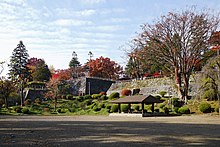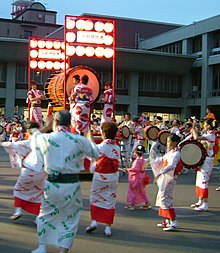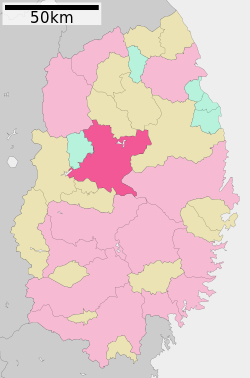|
Morioka
Morioka (盛岡市, Morioka-shi) is the capital city of Iwate Prefecture located in the Tōhoku region of northern Japan. On 1 August 2023, the city had an estimated population of 283,981 in 132,719 households,[1] and a population density of 320 per square kilometre (830/sq mi). The total area of the city is 886.47 square kilometres (342.27 sq mi). GeographyMorioka is located in the Kitakami Basin in central Iwate Prefecture, at the confluence of three rivers, the Kitakami, the Shizukuishi and the Nakatsu. The Kitakami River is the second largest river on the Pacific side of Japan (after the Tone River) and the longest in the Tōhoku region. It runs through the city from north to south and has a number of dams within the city boundaries, including the Shijūshida Dam and Gandō Dam. An active volcano, Mount Iwate, dominates the view to the northwest of the city. Mount Himekami is to the north and Mount Hayachine can sometimes be seen to the southeast.[citation needed] Surrounding municipalitiesIwate Prefecture DemographicsPer Japanese census data,[2] the population of Morioka peaked at around the year 2000 and has slightly declined since.
ClimateMorioka has a cold, humid continental climate (Köppen Dfa) characterized by warm, short summers and long, cold winters with heavy snowfall. The average annual temperature in Morioka is 10.2 °C (50.4 °F). The average annual rainfall is 1,314 millimetres (51.7 in) with July as the wettest month. The temperatures are at their highest on average in August, at around 23.7 °C (74.7 °F), and lowest on average in January, at around −2.4 °C (27.7 °F).[3]
History The area of present-day Morioka has been continuously inhabited since the Japanese Paleolithic period. Numerous Jōmon, Yayoi and Kofun period tombs and remains have been found. The Emishi inhabited the area into the Heian period. During the Enryaku era of the Heian period, Sakanoue no Tamuramaro, was ordered north to Shiwa Castle in 803 AD, as a military center to extend the domination of the imperial dynasty over Mutsu Province. The area was later ruled by the Abe clan until their destruction during the Former Nine Years War at the hands of the Minamoto and Kiyohara clans. The Kiyohara were in turn defeated in the Gosannen War and the area came under the control of the Ōshū Fujiwara Clan based in Hiraizumi, to the south of Morioka. After the Ōshū Fujiwara were destroyed by Minamoto no Yoritomo at the start of the Kamakura period, the area was disputed by several samurai clans until the Nanbu clan, based in Sannohe to the north, expanded their territory during the Sengoku period and built Kozukata Castle in 1592. Following the Battle of Sekigahara and the formal recognition of Morioka Domain under the Tokugawa shogunate, Kozukata Castle was renamed Morioka Castle.[6] Its name was changed from 森岡 to 盛岡 (both read as "Morioka")[7] During the Boshin War of the Meiji Restoration, Morioka Domain was a key member of the pro-Tokugawa Ōuetsu Reppan Dōmei. After the start of the Meiji period, the former Morioka Domain became Morioka Prefecture in 1870, and part of Iwate Prefecture from 1872. With the establishment of the modern municipality system on April 1, 1889, the city of Morioka was established as the capital of Iwate Prefecture. The city was connected by train to Tokyo in 1890. The city emerged from World War II with very little damage, having been subject to only two minor air raids during the war.[8] On January 10, 2006, the village of Tamayama was merged into Morioka. Morioka was proclaimed a core city in 2008, with increased local autonomy. During the 2011 Tōhoku earthquake, Morioka was hit by a 6.1 earthquake, and numerous aftershocks, but with little damage other than extensive power outages.[9] Government Morioka has a mayor-council form of government with a directly elected mayor and a unicameral city legislature of 38 members. Morioka contributes ten seats to the Iwate Prefectural legislature. In terms of national politics, the town is part of Iwate first district of the lower house of the Diet of Japan. EducationColleges and universityHigh schoolsMorioka has eight public high schools operated by the Iwate Prefectural Board of Education.
There is also one public high school operated by the city government and ten private high schools TransportationRailway
Highway
Local attractions
SportsSports venuesSports teams
ReligionTemples and shrines
CuisineMorioka attracts tourists with local noodles such as jajamen, reimen, and wanko soba. Brewing is also a thriving industry of the city. Nambu senbei, a type of rice cracker, is considered a local specialty. Media
International relations
Notable people
References
External linksWikimedia Commons has media related to Morioka, Iwate.
|
||||||||||||||||||||||||||||||||||||||||||||||||||||||||||||||||||||||||||||||||||||||||||||||||||||||||||||||||||||||||||||||||||||||||||||||||||||||||||||||||||||||||||||||||||||||||||||||||||||||||||||||||||||||||||||||||||||||||||||||||||||||||||||||||||||||||||








